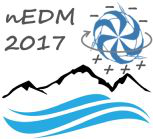Speaker
Skyler Degenkolb
(Institut Laue-Langevin)
Description
The most severe difficulty in measuring the neutron EDM is low achievable density of ultracold neutrons; this is addressed by the new source SuperSUN, currently under construction at the Institut Laue-Langevin. The intense primary cold beam H523 will be shaped by a unique tapered guide geometry, and guided for a further three meters inside an 11-liter converter volume with circular cross-section. UCNs produced by downscattering in the converter medium of ultrapure superfluid $^4\!$He will be trapped by a combination of magnetic and neutron-optical potentials; they can be released by a cold mechanical valve for extraction into room-temperature experimental environments. The source will be commissioned in two phases: Phase I with only material trapping of UCNs, and Phase II introducing a superconducting octupole magnet to achieve long storage times and automatic polarization.
PanEDM, the first experiment planned for the SuperSUN source, directly addresses the second key experimental limitation: systematic errors arising from magnetic field inhomogeneity. A five-layer magnetic shield in two dismountable parts reduces the magnitude and drift of magnetic field gradients over the cubic volume of ~125 liters that contains the storage cells for Ramsey spectroscopy. Residual field homogeneity and temporal stability for weak external perturbations have been respectively demonstrated at the levels of 100 pT/m absolute, and 1 pT/m over hours. Systems of atomic magnetometers and fluxgates monitor the magnetic environment, providing crucial systematic checks and diagnostic information.
Funding Agency
Programme ANR : Défi de tous les savoirs (DS10) 2014
DFG SPP 1491, Cluster of Excellence 'Universe'
| degenkolb@ill.fr |
Primary author
Skyler Degenkolb
(Institut Laue-Langevin)
Co-authors
Douglas Beck
(University Of Illinois at Urbana-Champaign)
Oliver Zimmer
(Institut Laue-Langevin)
Peter Fierlinger
(Technische Universität München)
Tim Chupp
(University of Michigan, Ann Arbor)

